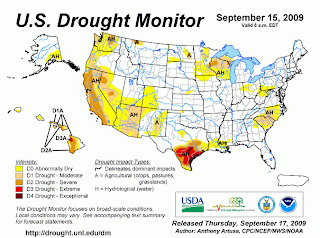The Water Policy Interim Committee, on which I serve, met for its second meeting in Helena yesterday. There was an update on our 2009 statewide water year, water demonstrations by the Montana Water Center (based in Bozeman!), discussions on legal definitions and statutes, and progress on groundwater investigation from a law that passed last session.


2009 was Montana’s best water year (precipitation, snowpack, groundwater) since 1997. The entire Intermountain West is in the best shape for hydrology and agriculture that it’s been in years. In Montana, precipitation in the spring was slim, but cooler temperatures helped keep crop growth slow until rain and warmer temperatures came in summer. August and September have been dry, but that’s okay; wheat is ripening and drier conditions are better for field work. Spring wheat harvest has been up: 28 bushels per acre on average, higher than 26.4/acre (the five-year average). Durum is up, too: 26 b/acre, higher than 24.2 (5 yr avg).
But we’re headed into another El Nino cycle, with drier and hotter conditions, and so our water future may not be nearly as good as this year.
The definition of navigability of rivers and streams has been a hot topic of late, since administrative determinations and court cases have focused on state ownership of the beds of navigable rivers. Our fine legislative counsel described three definitions of navigability (two federal, one state) and the specific applications of those definitions.
One of the most important efforts in the state now is the Groundwater Investigation Program. Much of our water use is from aquifers: subsurface deposits of water. Knowing the quantity, quality, and demand on our aquifers is key to managing our water resources so that we have what we need. Currently, there are forty sites being monitored, with some of the state’s high-growth areas garnering attention. Sites with many individual wells, stream depletion (pre-stream capture of water), and problems with contamination (sometimes from septic tanks. Eeeuuw.)
There is also a focus on groundwater permits and more and more exempt wells (mostly domestic wells for homes) drilled in closed basins. A closed basin is a drainage in which all of the water that’s available is claimed (appropriated), and there is no more available. There is much more area than funding currently available for the program, but the emphasis to start is the high-growth, contaminated areas. Let’s focus our attention there and fix those problems first, establish a baseline of groundwater quantity, quality, and demand, and then expand the program to other areas.
The Montana Water Center presented examples and demonstrations of artesian pressure (wells) versus atmospheric pressure (surface water or the water table), streambank protections, groundwater contamination, and surface water runoff and pollution.
These are the issues that the WPIC and water wonks like me are working on. I love this work. Water is the most important resource our state has. I’ll keep working to protect it for use by Montanans.

And I’ve been shopping some back-to-school sales lately. Check out the shoes: